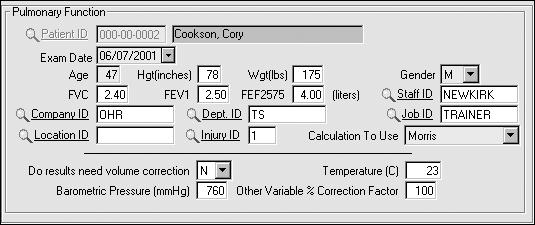PFT
Use SYSTOC's Pulmonary Function Testing (PFT) to record and comply with OSHA’s respiratory protection (CFR 1910.134) and respiratory surveillance (CFR 1910.1043 and others) standards.
PFTs measure several values, two of which are essential. Forced Vital Capacity (FVC) is the total volume of air you can blow out of your lungs. Forced Expiratory Volume (FEV1) is the volume of air you can blow out in one second. A third measurement, Forced Expiratory Flow (FEF 25%-75%) is a measure of the amount of air you can blow out during the center portion of the exhalation. It is a more sensitive measure of early airway disease than is the FEV1. A patient’s PFT results are compared to calculated normal values corresponding to his/her age, height, and sex. These calculated values are called predicted values, and they are generated from predictive equations. See PFT Predictive Equations for more information.
You must press F2 and run the PFT Results report to analyze your test results and see trends over time. If you wish to print an explanation of the results for the patient, specify Y in the PFT Description Sheet? field.

| Label | Description |
|---|---|
| Patient ID | Patient's identification number. |
| Exam Date | Date of the test. |
| Age | Calculated from the birth date in the patient's record. Required field. |
| Hgt | Height, in inches. Required field. |
| Wgt | Weight, in pounds. |
| Gender | Defaulted from patient's record. |
| FVC | Forced Vital Capacity. |
| FEV1 | Forced Expiratory Volume. |
| FEF2575 | Forced Expiratory Flow 25%-75%. |
| Staff ID | Medical staff person administering the test. |
| Company ID | Company where patient worked at time of the test. |
| Department ID | Department at time of the test. |
| Job ID | Job ID at time of the test. |
| Location ID | Multi-site location ID. |
| Injury ID | Appropriate injury ID number if activity is related to an injury (leave blank if this test is not related to an injury/illness for this patient). |
| Calculation To Use | Defaulted from selection in , but you may select an alternate calculation from list. The analysis of PFT results is based on the equation that is specified in the Calculation to Use field. The analysis determines if the patient's test results are within a normal range for his/her age, height, and sex compared to the normal (predictive) values calculated by the method you choose. |
| Volume correction | Indicate Y if you have the type of spirometer that needs volume correction or N if the spirometer does its own correction; then complete the other related fields. Even if you responded N you must still complete the Temperature and Barometric Pressure fields in order to have that information print on reports. |
| Temperature | Measured in degrees Centigrade (part of volume correction). |
| Barometric Pressure | Measured in mmHg (part of volume correction). |
| Other Variable % Correction Factor | Permits adjustments for special
circumstances, if desired.
|